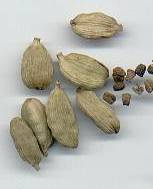|
|||||
|
|||||||
|
    An initiative of :Stichting Food-Info
|
| Food-Info.net> Food Products > Spices Cardamom (Elettaria cardamomum)Plant familyZingiberaceae (ginger family). Botanical synonymsAmomum cardamomum OriginSouthern India and Sri Lanka. Indian cardamom is slightly smaller, but more aromatic. Although India is the largest producer of cardamom, only a small share of the Indian production is exported because of the large domestic demand. The main exporting country is Guatemala, where cardamom cultivation has been introduced to less than a century ago and where all cardamom is grown for export. Used plant partSeeds. Because elsewise the lose fragrance rather quickly, normally the whole fruits (pods) are sold. Sensoric qualitySweet and aromatic, very pleasant. Main constituentsThe content of essential oil in the seeds is strongly dependant on storage conditions, but may be as high as 8%. In the oil were found a-terpineol 45%, myrcene 27%, limonene 8%, menthone 6%, ß-phellandrene 3%, 1,8-cineol 2%, sabinene 2% and heptane 2%. (Phytochemistry, 26, 207, 1987)
 Green cardamom pods and seeds UseCardamom is often named as the third most expensive spice in the world (after saffron and vanilla), and the high price reflects the high reputation of this most pleasantly scented spice. Despite its numerous applications in the cooking styles of Sri Lanka, India and Iran, 60% of the world production is exported to Arab (South West Asia, North Africa) countries, where the larger part is used to prepare coffee. Cardamom-flavoured coffee, almost a symbol for Arab hospitality, can be prepared by simply adding freshly ground cardamom seeds to the coffee powder; alternatively, a few cardamom pods may be steeped in the hot coffee. Bedouins (Arabic nomades) sometimes own coffee pots that can keep several cardamom capsules in their spouts; the coffee gets in contact with the spice only during being poured into the glass. In Ethiopia, preparation of coffee plays an important rôle and involves highly developed rituals (coffee ceremony). Coffee beans are always toasted immediately before usage, often together with spices (cloves, cardamom). After letting them cool, they are ground, and the coffee is prepared. On serving, other flavourings might be added, e.g., fresh leaves of rue. Yet not all cardamom is consumed for coffee in Arab countries; it is also used for cookery. The spicy mixture baharat from the Arabic peninsular contains cardamom as well as the fiery paste zhoug from Yemen. Arabs also like cardamom to their meat-and-rice dishes (e.g., kabsah), which may contain a multitude of spices similar to Indian biriyanis . Furthermore, cardamom is a popular spice in Northern Africa and Eastern Africa, where population is predominantly Arabic: It appears in the Moroccan mixture ras el hanout or the famous Ethiopian spice berebere . In Europe, cardamom is rather unknown, but may appear in some cookie recipes (for example, German Lebkuchen). Nevertheless, usage is low, except in Scandinavian countries, where cardamom is popular not only for cookies and sweet breads but also for pastries and sausages. In the Moghul cuisine (Northern India), cardamom is abundantly used in the delicious rice dishes called biriyanis , but it is also found in several mild meat dishes from the same region. In Sri Lanka, the pods are added to fiery beef or chicken curries, together with cinnamon. Cardamom-flavoured sweets are found all over the Indian subcontinent. The seeds lose their flavour quickly when ground; even left entire, the seed show a loss of about 40% of the essential oil per year. Therefore, only whole cardamom pods should bought; before usage, the pods should be crushed. Green pods are significantly superior in fragrance to the yellow or white bleached ones. ource : www-ang.kfunigraz.ac.at/~katzer/engl/spice_welcome.html |
|
| ||
| Food-Info.net is an initiative of Stichting Food-Info, The Netherlands | ||||||